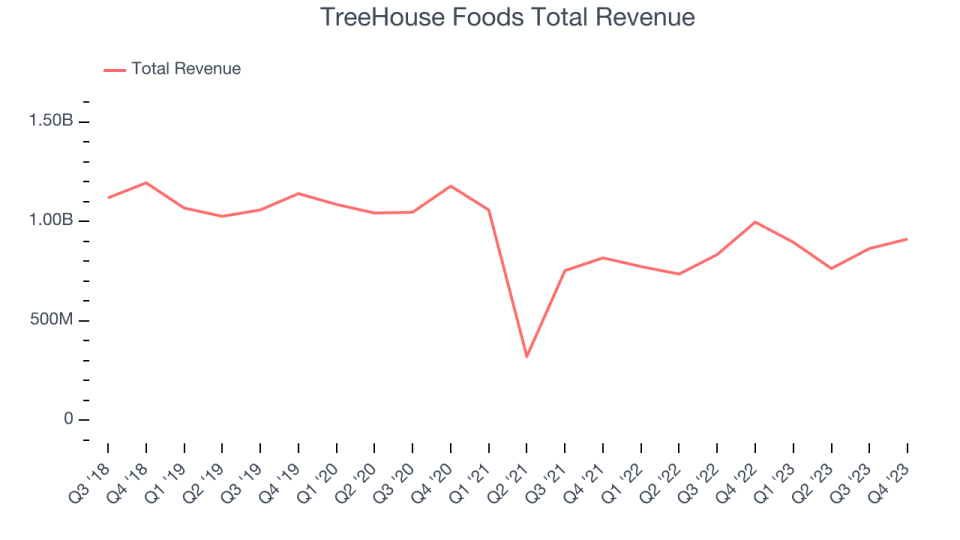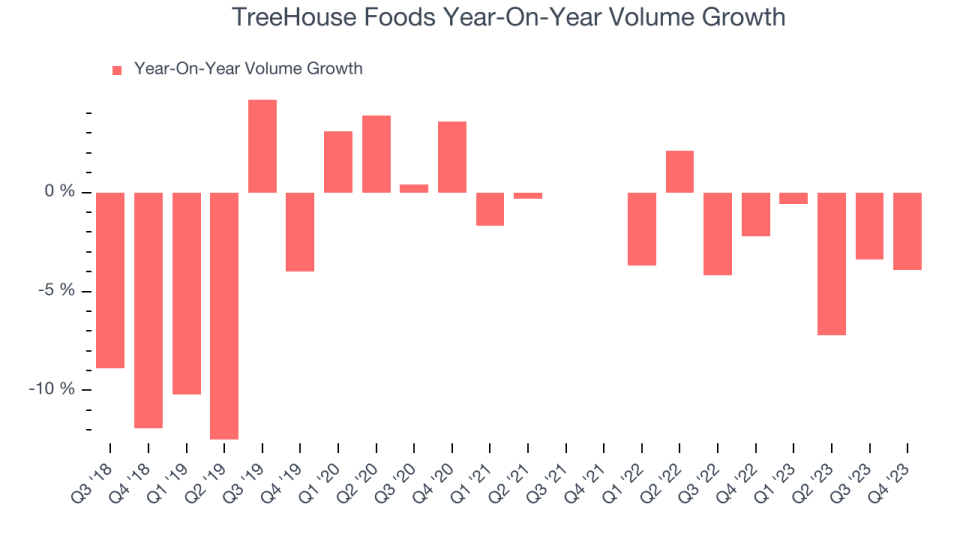TreeHouse Foods (NYSE:THS) Misses Q4 Sales Targets

Private label food company TreeHouse Foods (NYSE:THS) missed analysts' expectations in Q4 FY2023, with revenue down 4.8% year on year to $910.8 million. Next quarter's revenue guidance of $795 million also underwhelmed, coming in 11.4% below analysts' estimates. It made a non-GAAP profit of $0.77 per share, improving from its loss of $0.41 per share in the same quarter last year.
Is now the time to buy TreeHouse Foods? Find out by accessing our full research report, it's free.
TreeHouse Foods (THS) Q4 FY2023 Highlights:
Revenue: $910.8 million vs analyst estimates of $925.2 million (1.6% miss)
EPS (non-GAAP): $0.77 vs analyst estimates of $0.73 (6.1% beat)
Revenue Guidance for Q1 2024 is $795 million at the midpoint, below analyst estimates of $897.1 million
Management's revenue guidance for the upcoming financial year 2024 is $3.47 billion at the midpoint, missing analyst estimates by 2.8% and implying 1% growth (vs 4.7% in FY2023)
Management's adjusted EBITDA guidance for the upcoming financial year 2024 is $375 million at the midpoint, missing analyst estimates of $390 million by 3.8%
Free Cash Flow of $80.5 million, up 110% from the previous quarter
Gross Margin (GAAP): 16.7%, up from 14.3% in the same quarter last year
Organic Revenue was down 8% year on year
Sales Volumes were down 3.9% year on year
Market Capitalization: $2.36 billion
"TreeHouse Foods made important progress in 2023 to advance our portfolio strategy focused on higher-growth, higher-margin categories, enhance our supply chain capabilities, and improve our service levels," said Steve Oakland, Chairman, Chief Executive Officer and President.
Whether it be packaged crackers, broths, or beverages, Treehouse Foods (NYSE:THS) produces a wide range of private-label foods for grocery and food service customers.
Packaged Food
As America industrialized and moved away from an agricultural economy, people faced more demands on their time. Packaged foods emerged as a solution offering convenience to the evolving American family, whether it be canned goods, prepared meals, or snacks. Today, Americans seek brands that are high in quality, reliable, and reasonably priced. Furthermore, there's a growing emphasis on health-conscious and sustainable food options. Packaged food stocks are considered resilient investments. People always need to eat, so these companies can enjoy consistent demand as long as they stay on top of changing consumer preferences.The industry spans from multinational corporations to smaller specialized firms and is subject to food safety and labeling regulations.
Sales Growth
TreeHouse Foods is larger than most consumer staples companies and benefits from economies of scale, giving it an edge over its smaller competitors.
As you can see below, the company's revenue has declined over the last three years, dropping 7.6% annually as consumers bought less of its products.

This quarter, TreeHouse Foods missed Wall Street's estimates and reported a rather uninspiring 4.8% year-on-year revenue decline, generating $910.8 million in revenue. The company is guiding for a 6.9% year-on-year revenue decline next quarter to $795 million, a reversal from the 15.1% year-on-year increase it recorded in the same quarter last year. Looking ahead, Wall Street expects sales to grow 4.8% over the next 12 months, an acceleration from this quarter.
Unless you’ve been living under a rock, it should be obvious by now that generative AI is going to have a huge impact on how large corporations do business. While Nvidia and AMD are trading close to all-time highs, we prefer a lesser-known (but still profitable) semiconductor stock benefitting from the rise of AI. Click here to access our free report on our favorite semiconductor growth story.
Volume Growth
Revenue growth can be broken down into changes in price and volume (the number of units sold). While both are important, volume is the lifeblood of a successful staples business as there’s a ceiling to what consumers will pay for everyday goods; they can always trade down to non-branded products if the branded versions are too expensive.
To analyze whether TreeHouse Foods generated its growth from changes in price or volume, we can compare its volume growth to its organic revenue growth, which excludes non-fundamental impacts on company financials like mergers and currency fluctuations.
Over the last two years, TreeHouse Foods's average quarterly sales volumes have shrunk by 2.9%. This decrease isn't ideal as the quantity demanded for consumer staples products is typically stable. Luckily, TreeHouse Foods was able to offset fewer customers purchasing its products by charging higher prices, enabling it to generate 9.8% average organic revenue growth. We hope the company can grow its volumes soon, however, as consistent price increases (on top of inflation) aren't sustainable over the long term unless the business is really really special.

In TreeHouse Foods's Q4 2023, sales volumes dropped 3.9% year on year. This result was a further deceleration from the 2.2% year-on-year decline it posted 12 months ago, showing the business is struggling to push its products.
Key Takeaways from TreeHouse Foods's Q4 Results
It was encouraging to see TreeHouse Foods slightly top analysts' EPS expectations this quarter. That stood out as a positive in these results. On the other hand, organic revenue was weak and below expectations. Also, its revenue and adjusted EBITDA guidance for the coming year both missed analysts' expectations. Overall, the results could have been better. The company is down 4.3% on the results and currently trades at $40.94 per share.
TreeHouse Foods may have had a tough quarter, but does that actually create an opportunity to invest right now? When making that decision, it's important to consider its valuation, business qualities, as well as what has happened in the latest quarter. We cover that in our actionable full research report which you can read here, it's free.
